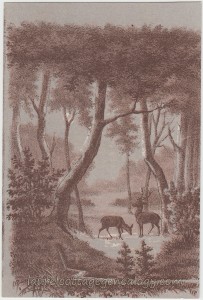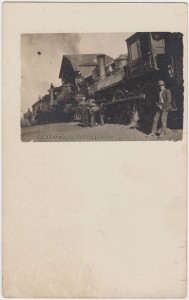





Trade cards, set of five. Circa 1885 – 1894. Shober & Carqueville Lithograph Co., Chicago Illinois.
Price for the set: $15.00 Size: About 2 and 3/4 x 4 and 1/4″
A set of five advertising cards put out by the Shober & Carqueville Lithograph Company of Chicago, showcasing at least one lithograph based on the artwork of London-born Sir Edwin Landseer (1802 – 1873.) Per a Wiki entry, there were fourteen Landseer children, seven of whom survived to adulthood, and all seven became artists. Edwin’s older brother Thomas (1793 or ’94 -1880) is known for having done engravings and etchings of Edwin’s work. The last image shown here, that of the man driving the horse-drawn sled, does not have any printing on the back, but all the others show the same identification as the image directly above. The top left of the majestic stag is easily verified as being from the famous oil painting by Edwin Landseer, which was done in 1851 and is called The Monarch of the Glen. (Yes, I know there was a British t.v. series, too, by this name!) If you’ve clicked on the link, you’ve found that this painting (not to mention the artist’s themselves) has had a rather fascinating story to tell. You’ll also immediately notice that the mountains and clouds in the original are missing from the trade card displayed here.
The Shober & Carqueville Lithograph Company was formed from the association of Charles Shober and Edward Carqueville. According to biographical info in volume 4 of Industrial Chicago, Carqueville was born in Posen, Prussia in 1841, coming to Chicago in 1857. He began working for Keen & Shober, where he learned the art of lithography. In 1865 he formed the Chicago Lithograph Company which operated till it was destroyed by the Great Fire of 1871. Afterwords the Charles Shober & Company was formed, with Carqueville as a partner. This name later changed to the Shober Lithograph Company, and then to the Shober & Carqueville Lithograph Company. The latter name was supposedly in place by at least 1894, when it was mentioned as the “current” name for said company in the aforementioned Industrial Chicago publication, but we see this company name as early as 1885 per Chicago city directories. From online records we see that Edward Carqueville had a number of sons to carry on the business and it appears (from the city directories again) that the company was being passed down around 1896 or so, with the 1896 directory for Edward showing the business name of Carqueville Lithograph Company, and evidence of one or more of his sons appearing in business with him. Edward Carqueville died in March of 1898.
Sources: The Monarch of the Glen. n.d. http://en.wikipedia.org/wiki/The_Monarch_of_the_Glen_%28painting%29 (accessed January 15, 2015).
Edwin Henry Landseer. n.d. http://en.wikipedia.org/wiki/Edwin_Henry_Landseer (accessed January 15, 2015).
Thomas Landseer. n.d. http://en.wikipedia.org/wiki/Thomas_Landseer (accessed January 15, 2015).
Industrial Chicago: The Commercial Interests, Vol. 4. Chicago: The Goodspeed Publishing Company, 1894. p. 487. (Google eBook)
Edward Carqueville. Find A Grave Memorial# 119060120. (Findagrave.com)
The Lakeside Annual Directory of the City of Chicago,1885. Chicago: The Chicago Directory Co. p. 292. Ancestry.com. U.S. City Directories, 1821-1989.
The Lakeside Annual Directory of the City of Chicago,1896. Chicago: The Chicago Directory Co. p. 385. Ancestry.com. U.S. City Directories, 1821-1989
























